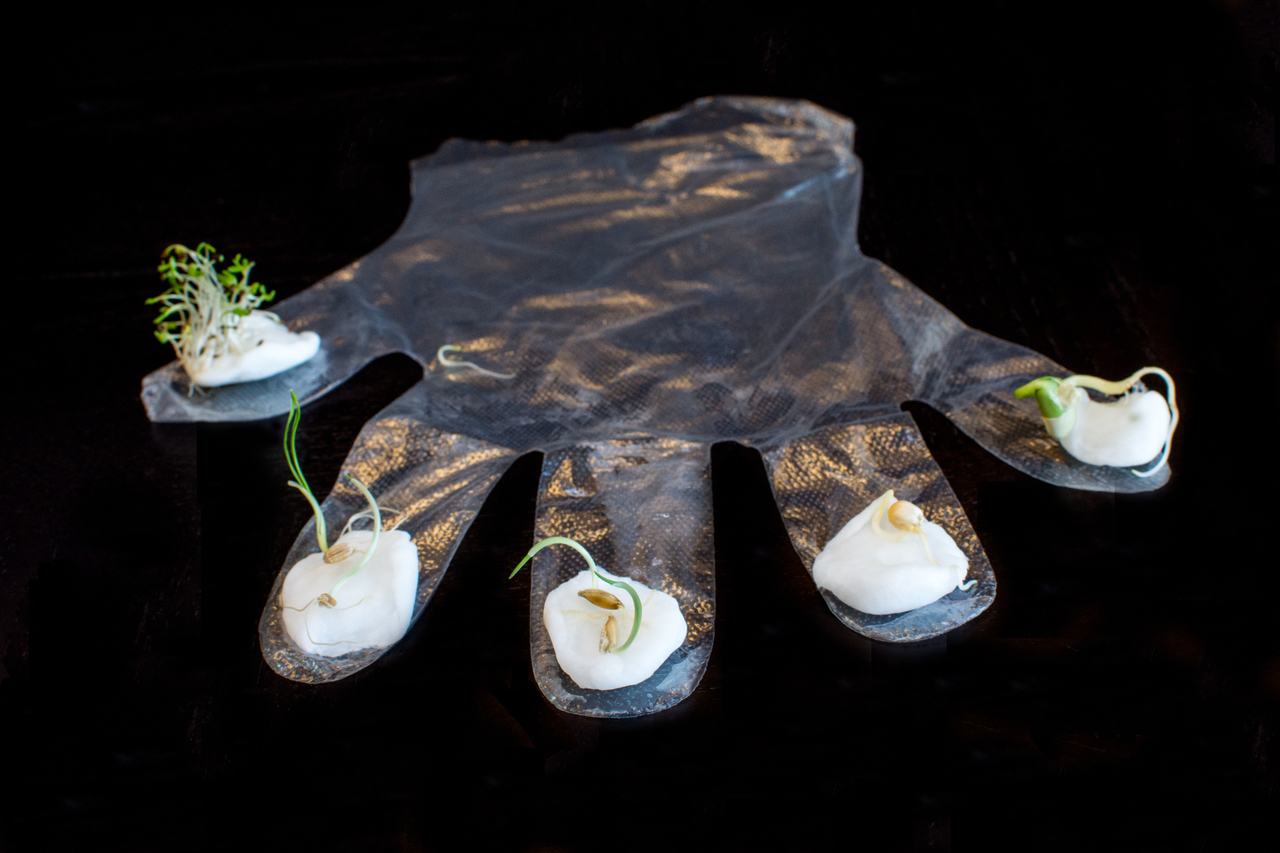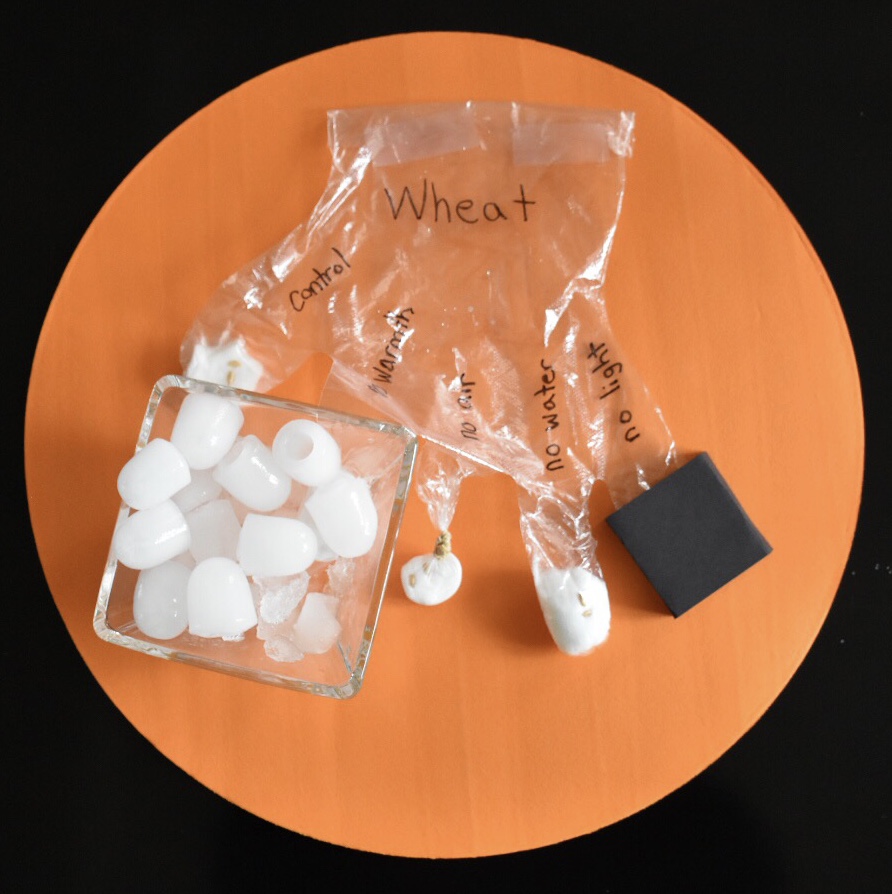Farming in a Glove (Grades K-2)
Students observe how a seed sprouts and investigate the conditions necessary for germination to occur.
Background
Lesson Activities
Recommended Companion Resources
Credits
Author
Sue Knott, Debra Spielmaker, and Lynn Wallin | Minnesota Agriculture in the Classroom and National Center for Agricultural Literacy (NCAL)
Standards
Texas Content Area Standards
-
ELA: K.110.2.b.1
Developing and sustaining foundational language skills: listening, speaking, discussion, and thinking - - oral language. The student develops oral language through listening, speaking, and discussion.
- ELA: K.1.C: The student is expected to share information and ideas by speaking audibly and clearly using the conventions of language.
- ELA: K.1.D: The student is expected to work collaboratively with others by following agreed-upon rules for discussion, including taking turns.
-
ELA: K.110.2.b.3
Developing and sustaining foundational language skills: listening, speaking, reading, writing, and thinking -- vocabulary. The student uses newly acquired vocabulary expressively.
- ELA: K.3.C: The student is expected to identify and use words that name actions; directions; positions; sequences; categories such as colors, shapes, and textures; and locations.
-
ELA: 1.110.3.b.1
Developing and sustaining foundational language skills: listening, speaking, discussion, and thinking - - oral language. The student develops oral language through listening, speaking, and discussion.
- ELA: 1.1.C: The student is expected to share information and ideas about the topic under discussion, speaking clearly at an appropriate pace and using the conventions of language.
- ELA: 1.1.D: The student is expected to work collaboratively with others by following agreed-upon rules for discussion, including listening to others, speaking when recognized, and making appropriate contributions.
-
ELA: 1.110.3.b.2
Developing and sustaining foundational language skills: listening, speaking, reading, writing, and thinking - - beginning reading and writing. The student develops word structure knowledge through phonological awareness, print concepts, phonics, and morphology to communicate, decode, and spell.
- ELA: 1.2.F: The student is expected to develop handwriting by printing words, sentences, and answers legibly leaving appropriate spaces between words.
-
ELA: 1.110.3.b.3
Developing and sustaining foundational language skills: listening, speaking, reading, writing, and thinking -- vocabulary. The student uses newly acquired vocabulary expressively.
- ELA: 1.3.D: The student is expected to identify and use words that name actions, directions, positions, sequences, categories, and locations.
-
ELA: 2.110.4.b.1
Developing and sustaining foundational language skills: listening, speaking, discussion, and thinking -- oral language. The student develops oral language through listening, speaking, and discussion.
- ELA: 2.1.C: The student is expected to share information and ideas that focus on the topic under discussion, speaking clearly at an appropriate pace and using the conventions of language.
- ELA: 2.1.D: The student is expected to work collaboratively with others by following agreed-upon rules for discussion, including listening to others, speaking when recognized, making appropriate contributions, and building on the ideas of others.
-
Math: K.111.2.b.7
Geometry and measurement. The student applies mathematical process standards to directly compare measurable attributes.
- Math: K.7.B: The student is expected to compare two objects with a common measurable attribute to see which object has more of/less of the attribute and describe the difference.
-
Math: K.111.2.b.8
Data analysis. The student applies mathematical process standards to collect and organize data to make it useful for interpreting information.
- Math: K.8.A: The student is expected to collect, sort, and organize data into two or three categories.
-
Math: 1.111.3.b.7
Geometry and measurement. The student applies mathematical process standards to select and use units to describe length and time.
- Math: 1.7.A: The student is expected to use measuring tools to measure the length of objects to reinforce the continuous nature of linear measurement.
-
Math: 1.111.3.b.8
Data analysis. The student applies mathematical process standards to organize data to make it useful for interpreting information and solving problems.
- Math: 1.8.A: The student is expected to collect, sort, and organize data in up to three categories using models/representations such as tally marks or T-charts.
-
Math: 2.111.4.b.9
Geometry and measurement. The student applies mathematical process standards to select and use units to describe length, area, and time.
- Math: 2.9.D: The student is expected to determine the length of an object to the nearest marked unit using rulers, yardsticks, meter sticks, or measuring tapes.
-
Social Studies: 2.113.13.c.16
Social studies skills. The student communicates in written, oral, and visual forms. The student is expected to:
- Social Studies: 2.113.13.c.16.E: communicate information visually, orally, or in writing based on knowledge and experiences in social studies
-
Social Studies: K.113.11.c.13
Social studies skills. The student applies critical-thinking skills to organize and use information acquired from a variety of valid sources, including technology. The student is expected to:
- Social Studies: K.113.11.c.13.D: sequence and categorize information
-
Social Studies: K.113.11.c.14
Social studies skills. The student communicates in oral and visual forms. The student is expected to:
- Social Studies: K.113.11.c.14.C: communicate information visually, orally, or in writing based on knowledge and experiences in social studies
-
Social Studies: 1.113.12.c.16
Social studies skills. The student applies critical-thinking skills to organize and use information acquired from a variety of valid sources, including technology. The student is expected to:
- Social Studies: 1.113.12.c.16.D: sequence and categorize information
-
Social Studies: 1.113.12.c.17
Social studies skills. The student communicates in oral, visual, and written forms. The student is expected to:
- Social Studies: 1.113.12.c.17.C: communicate information visually, orally, or in writing based on knowledge and experiences in social studies
-
Social Studies: 2.113.13.c.15
Social studies skills. The student applies critical-thinking skills to organize and use information acquired from a variety of valid sources, including technology. The student is expected to:
- Social Studies: 2.113.13.c.15.D: interpret oral, visual, and print material by sequencing, categorizing, identifying the main idea, predicting, comparing, and contrasting
-
Science: 2.112.4.b.1
Scientific and engineering practices. The student asks questions, identifies problems, and plans and safely conducts classroom, laboratory, and field investigations to answer questions, explain phenomena, or design solutions using appropriate tools and models. The student is expected to:
- Science: 2.112.4.b.1.A: ask questions and define problems based on observations or information from text, phenomena, models, or investigations
- Science: 2.112.4.b.1.B: use scientific practices to plan and conduct simple descriptive investigations and use engineering practices to design solutions to problems
- Science: 2.112.4.b.1.E: collect observations and measurements as evidence
-
Science: K.112.2.b.1
Scientific and engineering practices. The student asks questions, identifies problems, and plans and safely conducts classroom, laboratory, and field investigations to answer questions, explain phenomena, or design solutions using appropriate tools and models. The student is expected to:
- Science: K.112.2.b.1.A: ask questions and define problems based on observations or information from text, phenomena, models, or investigations.
- Science: K.112.2.b.1.B: use scientific practices to plan and conduct simple descriptive investigations and use engineering practices to design solutions to problems.
- Science: K.112.2.b.1.E: collect observations and measurements as evidence.
- Science: K.112.2.b.1.F: record and organize data using pictures, numbers, words, symbols, and simple graphs.
-
Science: K.112.2.b.3
Scientific and engineering practices. The student develops evidence-based explanations and communicates findings, conclusions, and proposed solutions. The student is expected to:
- Science: K.112.2.b.3.B: communicate explanations and solutions individually and collaboratively in a variety of settings and formats.
-
Science: K.112.2.b.12
Organisms and environments. The student knows that plants and animals depend on the environment to meet their basic needs for survival. The student is expected to:
- Science: K.112.2.b.12.A: observe and identify the dependence of plants on air, sunlight, water, nutrients in the soil, and space to grow.
- Science: K.112.2.b.12.B: observe and identify the dependence of animals on air, water, food, space, and shelter.
-
Science: K.112.2.b.13
Organisms and environments. The student knows that organisms resemble their parents and have structures and undergo processes that help them interact and survive within their environments. The student is expected to:
- Science: K.112.2.b.13.A: identify the structures of plants, including roots, stems, leaves, flowers, and fruits.
- Science: K.112.2.b.13.C: identify and record the changes from seed, seedling, plant, flower, and fruit in a simple plant life cycle.
-
Science: 1.112.3.b.1
Scientific and engineering practices. The student asks questions, identifies problems, and plans and safely conducts classroom, laboratory, and field investigations to answer questions, explain phenomena, or design solutions using appropriate tools and models. The student is expected to:
- Science: 1.112.3.b.1.A: ask questions and define problems based on observations or information from text, phenomena, models, or investigations.
- Science: 1.112.3.b.1.B: use scientific practices to plan and conduct simple descriptive investigations and use engineering practices to design solutions to problems.
- Science: 1.112.3.b.1.E: collect observations and measurements as evidence.
- Science: 1.112.3.b.1.F: record and organize data using pictures, numbers, words, symbols, and simple graphs.
-
Science: 1.112.3.b.3
Scientific and engineering practices. The student develops evidence-based explanations and communicates findings, conclusions, and proposed solutions. The student is expected to:
- Science: 1.112.3.b.3.B: communicate explanations and solutions individually and collaboratively in a variety of settings and formats.
-
Science: 1.112.3.b.12
Organisms and environments. The student knows that the environment is composed of relationships between living organisms and nonliving components. The student is expected to:
- Science: 1.112.3.b.12.B: describe and record examples of interactions and dependence between living and nonliving components in terrariums or aquariums.
-
Science: 2.112.4.b.3
Scientific and engineering practices. The student develops evidence-based explanations and communicates findings, conclusions, and proposed solutions. The student is expected to:
- Science: 2.112.4.b.3.B: communicate explanations and solutions individually and collaboratively in a variety of settings and formats
-
Science: 2.112.4.b.12
Organisms and environments. The student knows that living organisms have basic needs that must be met through interactions within their environment. The student is expected to:
- Science: 2.112.4.b.12.A: describe how the physical characteristics of environments, including the amount of rainfall, support plants and animals within an ecosystem
- Science: 2.112.4.b.12.B: create and describe food chains identifying producers and consumers to demonstrate how animals depend on other living things

